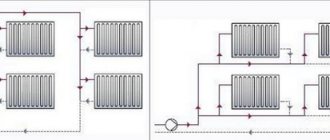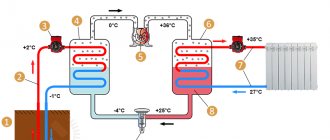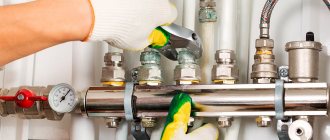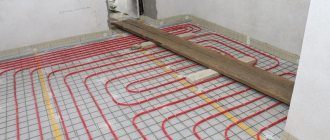SHARE ON SOCIAL NETWORKS
FacebookTwitterOkGoogle+PinterestVk
The surface of the earth receives a large amount of solar radiation every day, which is mostly not used. However, it is a free source of heat that can be converted into usable energy for human use. Solar collectors for heating a house ideally cope with this task. You can learn about the principle of their operation, what are the differences between them and how effective they are from this article.
Solar collectors are a profitable source of energy for heating a home
What is a solar collector and its operating principle?
A solar thermal collector is a technical device that is capable of converting solar energy into heat. It is used to produce hot water, which can later be used for various needs. The main difference between solar collectors and other versions of similar equipment is the principle of changing the density of water during heating. Cold masses displace the heated water flow upward, so there is no need to use additional pumping equipment.
Diagram of the operating principle of a solar thermal collector
The operating principle of the device is as follows. Solar energy is absorbed in a receiving device, which can be copper or glass surfaces of dark or black color. Such materials are characterized by good energy absorption capacity.
Solar water heaters are conveniently located on the roof, where there is plenty of space and maximum sunlight. Here, such devices do not take up useful space and do not disturb anyone. Next, the heat from the storage tank is transferred to the coolant tank. This could be water, antifreeze or another liquid that is used in the heating system.
In most cases, a mixture of 40% glycol and 60% distilled water is used. The coolant, which is heated to a certain temperature, is supplied to the radiators through a piping system.
The direction of water movement in the system can change thanks to the mixer. Cooled and warm water constantly replace each other. This natural circulation occurs due to the expansion of warm water, which rises, displacing cold water into the heating tank.
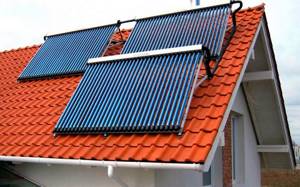
A solar collector is a device for converting solar energy into thermal energy
This heating system must be equipped with a thermal insulation layer at least 25-30 cm thick, which will ensure its efficient and stable operation. It is better to use a rectangular tank as a storage tank for coolant. A backup heating element can be located here. It will automatically come into operation when weather conditions are created that are not conducive to heating the coolant to the required temperature.
Vacuum solar collectors
A vacuum solar collector is a high-tech complex device designed to collect thermal solar energy and its subsequent processing into thermal energy, which is used in everyday life and industrial applications to provide heating and water heating in water supply systems. The solar vacuum collector is highly efficient and ergonomic, has high efficiency even in low light conditions and low temperatures, which makes it possible to use the system at any time of the year. The device allows you to convert infrared radiation penetrating through clouds and scattered rays into heat. Oventrop solar collectors are capable of heating water up to one hundred degrees Celsius even at subzero ambient temperatures.
Advantages and disadvantages of solar collectors for heating water
In summer, solar collectors are able to fully provide the house with hot water. In the off-season, such an alternative heating system can reduce the load on the gas boiler, which will reduce gas consumption, while reducing financial costs.
Important! In winter, solar collectors work inefficiently, which is due to the small amount of solar radiation.
The collector acts as an additional source of free heat, thereby reducing dependence on gas. In the summer, there will be no financial costs required to obtain hot water.

A solar collector can provide a house with warm water in summer
Installation of a solar collector does not require obtaining a permit. When choosing equipment, you should study in detail all available information and consult with a knowledgeable seller. The installation of the system must be entrusted to a specialist or done independently if you have certain skills and abilities in the field of plumbing. The average lifespan of the system is about 15 years. During this time, you can use free solar heat for your own needs.
The disadvantages of such a system include the large financial costs that will need to be incurred when purchasing solar collectors. The average cost of one element is $500-1000. A system consisting of two collectors and assembled on a turnkey basis will cost between $2300-3000.
The intensity of solar energy differs at different times of the year, so solar collectors cannot be used as the only source of heat. For the system to operate, you will need a storage tank, the purchase of which will increase the cost of installing a solar water heating system.
Heating collectors most suitable for heating a house in the central part of Russia
Developing the topic of using heating collectors in winter conditions, it would be nice to find out what type of heating element is best to choose in a particular case and not make a mistake in choosing a method for generating heat in winter.
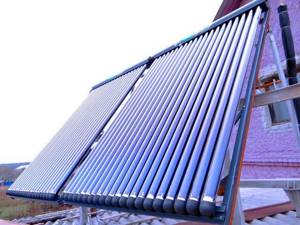
In conditions of low temperatures, vacuum collectors are a big winner
In conditions of low temperatures, a system of collectors using solar heat requires significantly more time in the morning to raise the temperature of the heat transfer medium and bring the entire heating system into an efficient, functional state compared to the spring-summer season.
The outer parts of solar collectors come into contact with the cold surrounding atmosphere, thereby losing a certain amount of energy. Flat-plate collectors lose their performance in winter at a fairly serious level. Vacuum collectors benefit greatly here, which, due to their serious thermal insulation (this function is performed by a vacuum), have almost the same efficiency as in the warm season. An airborne solar collector will also cope well with its task.
It turns out that to heat a house in Russia you can resort to using both types of devices. To heat a building of a specific area, it will be more profitable to use a vacuum collector. This is explained by the simple reason that when using flat collectors, to maintain the same required power, you will have to install two to three times more collectors. This fact raises the question of the economic feasibility of using solar collectors for heating in the cold season.

In winter, to supply the home with hot water for more efficient operation, it is necessary to install vacuum collectors
In addition to everything, it should be noted that in winter, to supply the home with hot water, for more efficient operation it is necessary to install a system of collectors, the operating principle of which is based on vacuum. This type of solar cells, using vacuum tubes, will provide the amount of heat necessary to heat water in both cloudy and cloudy weather in winter. In contrast, the installation of flat-plate collectors is significantly worse at performing this job. In addition, their operating principle has a significant drawback - a backup hot water supply device will be additionally used.
Solar collectors for home heating: types of installations
By design, solar collectors can be flat or vacuum. The latter option is a more common type, which is characterized by ease of installation, high efficiency, and the ability to provide the required amount of heat to the entire house. A vacuum solar collector for heating a house, the price of which exceeds the cost of a flat product, is represented by a complex design that can be used to fully heat a room and heat water in any season of the year.

According to the type of design, solar collectors are vacuum and flat
There is a special type of installation called a collector-concentrator. It is a system of parabolic reflectors, which are located on one curved surface, where sunlight is concentrated at certain points. To obtain the maximum effect, it is necessary to change the position of the device, which can be in two planes, following the movement of the sun.
Depending on the coolant, liquid and air designs are distinguished. In the first case, distilled water or antifreeze is used, and in the second, heated air is used.
According to the type of coolant used, a distinction is made between passive and active systems. In the first option, the solar collector is used in conjunction with a storage tank. This system is suitable for hot water supply and is not equipped with additional engineering elements. The active option involves the installation of a solar collector and other technical devices, such as a pump, storage tank, safety valves, and additional coolant heating devices. Such a system can be used for both hot water supply and home heating.

According to the type of use, collectors can be passive or active
The method of heat transfer can be indirect or direct. The first option assumes the presence of a storage tank in which the thermal energy received by the external circuit from solar radiation is transferred to the internal circuit circulating in the heating and hot water systems. In direct-flow systems that are used for hot water supply, water circulation in the collector circuit occurs under the influence of temperature differences and due to the presence of additional elements in the form of valves and taps.
Classification of solar collectors for heating according to the heating temperature of the coolant
Air or water solar collectors for heating a house can be classified according to the degree of heating of its working parts and coolant. Depending on this criterion, low-, medium- and high-temperature installations are distinguished. Low-temperature options can provide heating of the coolant up to 50 °C. Such thermal collectors are used to heat water in showers in the summer, in irrigation tanks, to create comfortable conditions on cool spring and autumn evenings.
Medium temperature systems provide heating of the coolant up to 80 °C. Such installations are used for heating rooms and swimming pools. It is most advisable to install solar collectors of this category when arranging a private home. High-temperature systems are capable of heating the coolant to a temperature of 250-300 °C. Such devices are recommended for use on an industrial scale. They are used for heating commercial buildings, production workshops and other technological premises.
High temperature systems involve a complex process of conversion and transfer of thermal energy. The structures have impressive dimensions, requiring a lot of free space for their installation. The process of manufacturing the system is very labor-intensive and costly, which is associated with the use of specialized equipment. You won't be able to do this on your own.
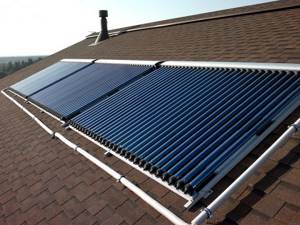
Based on heating temperature, collectors are classified into low-, medium- and high-temperature
Temperature division of water heating equipment
The consumer is offered a lot of different device options, but their main difference lies in the temperatures they achieve. According to this principle, they are made into three main types of collectors:
- The first is low temperatures (they give low temperatures up to 50 degrees Celsius); the main calculation of application is heating a pool or other options when there is no need to heat the water very much.
- Next come medium temperature collectors (they raise the temperature from 50 to 80 degrees) the main calculation of the application is for heating industrial buildings and residential premises.
Medium temperature collectors are used for heating industrial buildings and residential premises.
- The third type is high temperature collectors (used in industry to generate electricity with subsequent distribution to the central electrical network).
Design features of a flat solar collector
The most popular option, according to numerous reviews, is a flat-type solar collector, which you can make yourself. This system is effective for organizing hot water supply during the warm season. In winter, the efficiency of the device is very low.
The collector body has a flat square or rectangular shape. It is made of metal or other material with a high thermal conductivity coefficient. The product is coated with dark paint to improve absorbent properties. Inside the body there is a plate in which there is a coil made of a small-section copper tube. The coolant circulates through the tubes. To minimize heat loss, thermal insulation material is laid inside the housing.
To prevent debris from penetrating into the device body, it is closed on top with a glass or polycarbonate lid, which can increase heating. For the collector to operate efficiently, it must be periodically wiped to remove dirt and dust.
It is recommended to install a flat solar collector in the southern regions, where this option is characterized by the best price and efficiency indicators. Such a device is distinguished by its self-cleaning ability, high efficiency in summer and low cost.
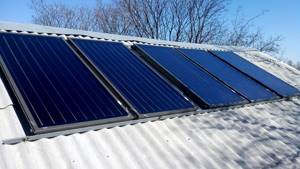
Flat-plate solar collectors are the most popular
However, flat collectors are characterized by significant heat losses, which arise due to the design features of the device. Such a system has low efficiency in the spring-autumn period. The structure is characterized by high windage, which causes the risk of damage to its elements during operation.
How do solar panels differ from collectors?
The first thing you need to know is the differences between a solar panel and a collector.
In the battery, thermal energy is converted into electrical energy, accumulated and can be used to operate electrical appliances, heat the coolant, etc. To assemble a solar battery, you need photocells connected in series in the housing. The collector is designed to heat a house directly using thermal energy. The sun heats the water entering the heating system; the same water can be used for autonomous hot water supply. Photocells are not required to install the collector, and you can easily gather materials for installation from your household.
Characteristics of a vacuum solar collector for heating a house in winter
A vacuum solar collector is a rather complex device. The main working element is an expensive light-absorbing bulb with a transparent surface in which the tube is located. The work is based on the principle of a thermos. The vacuum flask allows sunlight to pass into the inner tube, where there is no air, which allows up to 95% of heat to be retained.
Helpful advice! It is impractical to make a vacuum solar collector with your own hands, which is due to the specifics of the production technology.
The lower part of the internal vacuum tube for the solar collector is occupied by antifreeze, which turns into a gaseous state when heated. In its upper part, heat is transferred to the collector with the coolant. At the same time, the antifreeze cools and condenses, returning to its original state.
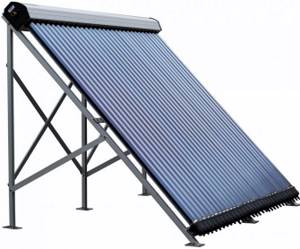
A vacuum solar collector is a complex device, so it is quite expensive
The vacuum solar collector is characterized by a high efficiency value in poor lighting conditions and temperatures below -37 °C. It was specially designed for northern latitudes and can function in the absence of direct solar radiation. To operate effectively, the structure requires constant maintenance, which consists of cleaning its surface from contamination.
Important! The collector must be mounted at a certain angle, as indicated in the installation instructions for the device.
The main disadvantage is the high cost of the structure. If at least one tube fails, repair will be problematic, since all products are mounted in series.
Structural drawings

Let's get started
Before building a solar collector, it is necessary to make the appropriate calculations and determine how much energy it should produce. But you shouldn’t expect high efficiency from a homemade installation. Having determined that there will be enough of it, you can begin.
The work can be divided into several main stages:
- Make a box
- Make a radiator or heat exchanger
- Make a front camera and storage device
- Assemble the collector
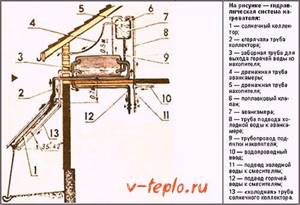
To make a box for a solar collector with your own hands, you should prepare an edged board 25-35 mm thick and 100-130 mm wide. Its bottom should be made of textolite, equipped with ribs. It should also be well insulated using polystyrene foam (but preference is given to mineral wool), covered with a galvanized sheet.
4 more effective ways to alternatively heat your home
Which you can learn about in our next article.
Having prepared the box, it’s time to make the heat exchanger. You should follow the instructions:
- It is necessary to prepare 15 thin-walled metal tubes 160 cm long and two inch pipes 70 cm long
- In both thickened tubes, holes are drilled with the diameter of the smaller tubes into which they will be installed. In this case, you need to ensure that they are coaxial on one side, the maximum step between them is 4.5 cm
- The next stage is that all the tubes need to be assembled into a single structure and welded securely
- The heat exchanger is mounted on a galvanized sheet (previously attached to the box) and fixed with steel clamps (metal clamps can be made)
- It is recommended to paint the bottom of the box in a dark color (for example, black) - it will better absorb solar heat, but to reduce heat loss, the external elements are painted white
- To complete the installation of the collector, it is necessary to install a cover glass near the walls, while not forgetting about reliable sealing of the joints
- A distance of 10-12 mm is left between the tubes and the glass
All that remains is to build a storage tank for the solar collector. Its role can be played by a sealed container, the volume of which varies about 150-400 l
. If you cannot find one such barrel, you can weld several small ones together.
Like the collector, the storage tank is thoroughly insulated from heat loss. All that remains is to make a fore-chamber - a small vessel with a volume of 35-40 liters. It must be equipped with a water-falling device (a swivel valve).

The most responsible and important stage remains - to assemble the collector together. You can do it this way:
- First you need to install the front camera and storage. It is necessary to ensure that the liquid level in the latter is 0.8 m lower than in the front chamber. Since a lot of water can accumulate in such devices, it is necessary to think about how they will be reliably shut off
- The collector is placed on the roof of the house. Based on practice, it is recommended to do this on the south side, tilting the installation at an angle of 35-40 degrees to the horizontal
- But you need to take into account that the distance between the storage tank and the heat exchanger should not exceed 0.5-0.7 m, otherwise the losses will be too significant
- At the end, the following sequence should be obtained: the front camera must be located above the drive, the latter - above the collector
The most important stage is coming - it is necessary to connect all the components together and connect the water supply network to the finished system. To do this, you will need to visit a plumbing store and purchase the necessary fittings, adapters, sockets and other shut-off valves. It is recommended to connect high-pressure sections with a pipe with a diameter of 0.5 inches, low-pressure sections with a diameter of 1 inch.
Commissioning is carried out as follows:
- The unit is filled with water through the bottom drainage hole
- The anterior chamber is connected and the fluid levels are adjusted
- It is necessary to walk along the system and check that there are no leaks
- Everything is ready for everyday use
Solar air collector for heating: product features
Air solar collectors use air as a heating medium for heating. The device can be made in two versions: in the form of a flat corrugated or perforated panel or a system of metal pipes.
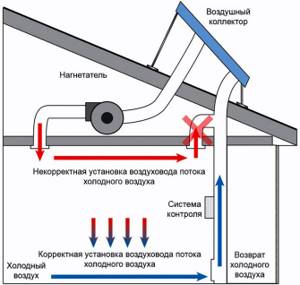
The operating principle of a solar air collector for heating a house
The simplest option is a flat absorber, consisting of a panel and a tube with an inlet and outlet pipe. All elements are located in a box, the back and side walls of which are covered with thermal insulation. The panel is made of copper or aluminum and painted black. It is covered with a transparent protective surface made of glass, plastic or polycarbonate.
The air entering the panel is heated by contact with the metal. The ribs on the surface of the product increase heat transfer. For maximum efficiency, the structure should be installed on the south side of the house, with high-quality insulation. The system can be organized with natural or forced coolant circulation. The last option involves installing a fan.
Related article:
Waste oil boiler: a reliable and budget option for heating a room
Operating principle and distinctive features. Types of device. How to make it yourself. Manufacturers and popular models.
A system with natural circulation is used extremely rarely, which is associated with the slow movement of air masses, resulting in significant heat losses. Solar Fox air solar collectors can operate at temperatures as low as 25 °C, while for a water solar system the optimal value is 45 °C. Such structures can only be used for air heating of the house. Collectors are not able to heat water. The devices are characterized by low efficiency, have very impressive dimensions, but have a simple design, are easy to install and are affordable.
Helpful advice! To increase the efficiency of solar air systems, collectors can be built into south-facing walls during the construction of a house.
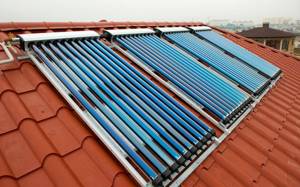
Solar air collectors can be flat or in the form of a system of pipes
The thermal conductivity of air is significantly lower than these indicators of water, which affects the efficient operation of the system. To avoid heat loss, all butt joints must be carefully insulated. Despite the existing shortcomings, the air solar collector copes well with the task of heating indoor air with a temperature difference between inside and outside of 15-17 ° C.
Characteristics of some collector models
These devices are well known in the domestic market:
- YaSOLAR (Russia ). The absorber is made of copper. The light-absorbing surface area is two “squares” with dimensions of 2065x1073x105 millimeters. The internal volume is 1.4 liters. The empty collector weighs 37 kilograms. Thermal rated power is 1.5 kW, subject to a lighting intensity of 900 W/sq. m. and the outside temperature is 20 °C. Anti-reflective glass with a thickness of 3.2 millimeters is used, which has a translucency of 92%. The height of the thermal insulation layer is 60 millimeters.
- SOKOL-EFFECT-A . The absorber is made of aluminum. The size of the absorbing surface is 2.06 "square". Thermal power - 1.5 kW at a lighting intensity of 900 W/sq.m. and the outside temperature is 20 °C. The device parameters are 1093 x 2008 x 76.7 millimeters with an internal volume of 1.4 liters. The weight of the empty device is 32 kilograms. Anti-reflective glass with a thickness of 3.2 millimeters is used.
- KAIROS VT 15B . The device measures 1910 x 1840 millimeters, weighs 51 kilograms and has 15 tubes with an outer diameter of 70 millimeters. The working pressure is 6 atmospheres. The internal volume is 4.6 liters. Heating stops at a temperature of 206 °C. The absorbing surface area is 1.5 square meters.
Requirements for materials for the manufacture of a homemade solar collector
To make the frame of a solar collector for heating with your own hands, plywood, wooden beams, OSB boards or other similar options are used. As an alternative, you can use an aluminum or steel profile with inserts made of similar materials, which will give the structure strength and reliability. However, such a case will have a high cost.
Materials must meet the requirements for structures located outdoors. Since the average service life of a solar collector is 20-30 years, it is necessary that the materials have high performance characteristics that will remain unchanged throughout the entire service life of the installation.
Wood for the body must be treated with water-polymer compositions and coated with paint and varnish emulsions. The steel profile must be reliably protected from corrosion.

Plywood, OSB boards or timber are used to make the collector frame
To make a heliostat absorber with your own hands, you use available materials. The coil can be made from rigid PVC pipe with fittings, flexible HDPE pipe, bent copper or metal tube. The heat exchanger of an old refrigerator is suitable for the absorber. The element can also be made from aluminum cans or plastic bottles. The main selection criterion is the thermal conductivity of the material.
To prevent heat loss, the housing should be insulated on all sides. For these purposes, mineral wool or polystyrene foam is mainly used. The foil version of the insulation has proven itself well, which will provide not only thermal insulation, but also reflection of the sun's rays from the surface.
Important! It is necessary to make grooves in the foam insulation layer for laying the coil.
The heat exchanger is covered with a protective surface, which can be tempered glass or monolithic polycarbonate. The material should have a grooved rather than smooth surface.
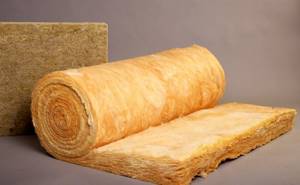
To prevent heat loss, the collector body is insulated with mineral wool or polystyrene foam
Making a flat-plate solar collector with your own hands
At the first stage, the solar collector for heating is calculated based on the area of the room. Its dimensions are also determined by the level of sun activity in a given region, the location of the house, and the characteristics of the area.
The collector body is made of wood or glass. You can use old glazed windows. To create an absorber, aluminum or copper tubes, a rolled rubber hose, and steel flat batteries are suitable. You can create a manifold from black polypropylene pipes.
Thermal insulation material in the form of polystyrene foam or mineral wool is placed on the bottom of the housing. Next, the entire area is covered with a metal sheet made of thin steel or aluminum to enhance the heat transfer effect.
The coil pipes are mounted on top, which are attached to the metal sheet using brackets. Its ends are brought out. The surface of the structure is covered with impact-resistant tempered glass or transparent polycarbonate, leaving a gap of 10-15 cm for good heat transfer. The storage tank is protected with heat-insulating material or painted black. A heating element is connected to it, from which the pipes for the heating system of the house are routed.
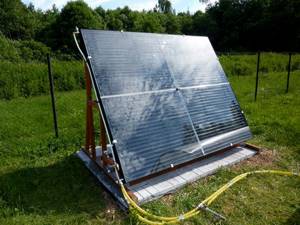
A flat-type solar collector can be made by hand
Important! All butt joints must be securely sealed.
Options for creating an air solar collector with your own hands
Making a traditional air solar collector for heating your home with your own hands begins with creating a frame from wooden boards. The back and end walls should be insulated with mineral wool. The housing is fixed to the wall. All gaps must be insulated with foam. On the sides there are holes for pipes for the entry and exit of air masses. External elements are securely wrapped with heat-insulating material.
A perforated metal sheet made of aluminum, which is characterized by high thermal conductivity and low cost, is used as an absorber. To increase selective qualities, it is coated with black paint. A sheet of glass or polycarbonate is placed on top.
Important! The degree of heating is determined by the dimensions of the solar panel.

Water pipes can be used as an absorber for the air collector
The absorber can be made of rectangular water pipes, which are installed on an aluminum sheet and fixed to it using mounting tape and self-tapping screws. The back wall of the wooden case is insulated with mineral wool, and the side walls with expanded polystyrene. The pipes are painted black and covered with a sheet of tempered glass or polycarbonate.
An even simpler design is made from corrugated sheets. The frame is made of wooden blocks. An exit hole is made in the bottom. Corrugated sheeting with many holes throughout the entire area of the product is laid on the beam, which will ensure air flow.
A good solution is to build an air collector on the window. This is a fairly effective option that allows you to heat the room well. The frame is made of aluminum frames and attached to the window in the form of a mosquito net. The rear wall is made of aluminum sheet, in which holes are made in the lower (for intake of cold air) and in the upper (for removal of warm air) parts. The role of an absorber can also be performed by black foil, which is covered with a protective PVC film.
Device and types
Conventionally, these systems can be classified into two types
:
- liquid (which we talk about in this material);
- air solar collectors, which use heated air rather than liquid.
They are also divided according to efficiency, because they provide different heat transfer. It depends on the materials used to make the battery and its area. The optimal location for the absorber is the roof
:
- receives the maximum amount of sunlight,
- has a large area
- The battery installed on the roof does not take up any useful space and does not interfere with anyone.
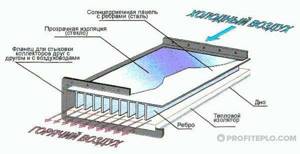
The design of the solar collector can be of several types, the main
:
- vacuum heating manifold, which has the most complex design. Vacuum solar collectors are excellent for heating rooms, heating water at any time of the year, they will completely provide a small house or cottage;
- A flat solar collector can be liquid or vacuum. This is the most common type because it is quite easy to install, yet it is efficient and can provide the house with the necessary amount of heat for heating the premises, and water for household needs;
- thermosiphon - glass or metal tubes are used as an absorber;
- tubular - the simplest type that can be made for a summer residence; it is quite primitive and not suitable for use in winter.
We are interested in a design that ensures the availability of hot water and heating in the house at any time of the year; we will focus on two optimal options, consider the design of a vacuum solar collector and a flat one.
Flat-plate collector
This is the most common type of collector that you can make yourself. Well suited for use in the warm season for heating water; in winter the efficiency decreases.
The design feature is as follows
:
- the body has a flat rectangular or square shape, made of metal or other material with a high thermal conductivity, coated with black paint;
- inside there is a plate in which a coil made of a copper tube of small cross-section is laid;
- coolant circulates through the tubes: water, propylene glycol, antifreeze, and other suitable liquids;
- also, thermal insulation material is placed inside the housing, which minimizes heat loss;
- When assembling a collector of this type, you need to stock up on a sheet of polycarbonate or glass, which will serve as a cover and perform two functions: prevent the penetration of debris and precipitation, and enhance heating.

Component of a flat-plate solar collector
Important! Before assembling the structure, you need to check the seams for tightness in order to prevent moisture, dust from entering the unit, and warm air from venting. Care tip! To avoid a decrease in efficiency, you need to regularly wipe the glass surface from dust and dirt.
Vacuum manifold
For water heating, vacuum-type solar collectors can be used. Thanks to their design features, they are more powerful: they are able to generate thermal energy, which is enough to heat water and heat rooms.
Design Features
:
- Tubes that are placed in flasks with the air pumped out allow to minimize losses;
- the tubes are covered on top with an absorption material that absorbs light energy, and inside they are filled with antifreeze (refrigerant);
- the ends of the tubes are connected to a pipe through which the coolant passes;
- when heated, the antifreeze boils and turns into steam, which, in turn, rises and heats the coolant;
- This design has a drawback: if at least one tube fails, repair becomes quite problematic, since they are connected in series. All the “internals” will have to be replaced.
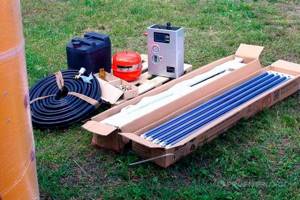
Such an air solar collector for heating will be more efficient and suitable for maintaining the temperature in the system in any season. Although in cold weather, the efficiency of a working collector may decrease slightly due to short daylight hours and low light activity.
Care tip! Pay attention to the inner surface of the water storage tank; it becomes covered with scale over time and needs cleaning. The frequency depends on the water quality in the area.
Please note: it is unrealistic to make vacuum tubes with pumped-out air in home-made conditions; you will have to buy them. This will slightly increase the costs of installing this type of collector.
Solar collector for home heating: reviews and recommendations for choosing a device
When choosing a solar collector, you should take into account some nuances. Flat models are more durable than other varieties. However, such structures are not suitable for repair. A minor breakdown can damage the entire absorption system, which leads to the cost of purchasing a new one. You can save money by making a flat solar water heater with your own hands, which heats the coolant 30-40 °C above the ambient temperature.
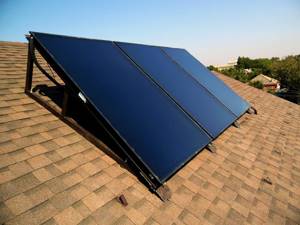
When choosing a collector, you need to take into account that flat models are more durable, but cannot be repaired
Vacuum solar heating systems are very sensitive to external influences and are more susceptible to damage, which is due to the fragility of hollow pipes. However, if one of the flasks fails, it can be replaced with a new one. This collector is much more efficient in winter than the flat version, since it provides heating over a wider range and is able to maintain the temperature for a long time.
The performance of a vacuum manifold depends on the size of the tubes. The shorter they are, the less thermal energy generation. The best option is a system with several flasks 2 m long and 6 cm wide. To ensure effective thermogenesis, a straight or U-shaped insert should be located in the inside of the flask.
Air options have a simple design, rarely require repairs, and can withstand very low temperatures. Their service life exceeds the service life of other systems. However, they do not heat the room very well.
Helpful advice! Before purchasing a system, it is necessary to perform a calculation of the solar collector with the participation of a qualified specialist in this field of activity.
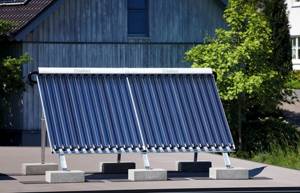
Vacuum collectors provide heating over a wider range than flat-plate collectors
It is important to choose the right location to install the system. A DIY solar water heater must be placed on the south side or with a deviation of 30° from it. Measures must be taken to remove precipitation during the winter period. The device can be positioned vertically, which will eliminate the problems associated with clearing snow from the collector. However, this situation will negatively affect the efficiency of the heater.
Strength of the heating element for heating water
There are rumors in certain circles that flat heating elements are much more durable than vacuum ones, this is quite simple to explain: a flat element for heating water is a single, uniform panel. By its appearance, a flat heater shows that it is more resistant to mechanical stress. However, it is worth keeping in mind that even panels from world-famous manufacturers can be quite easily damaged. But in principle, natural disasters, huge hailstones, hurricanes that uproot trees, the fall of meteorites, which, in the end, can cause damage to the collector, are not such a frequent occurrence in everyday life to pay special attention to them.
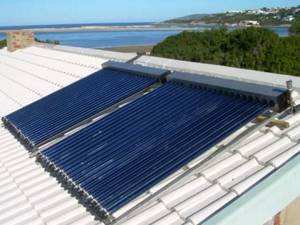
It is much more practical to use vacuum solar collectors
If we look at the issue from the practical side of heating water, then it is much more practical to use vacuum solar collectors. This heating element consists of a large set of glass tubes. If for some reason one of the tubes is damaged, the principle of operation is such that it can be easily replaced with a new one. An additional advantage is that it is not necessary to replace a damaged element immediately upon its breakdown. The collector will continue to perform its functions even with damaged heating elements.
If the flat solar collector is damaged, it stops functioning and requires immediate troubleshooting - this is a rather unpleasant principle of its operation.
Sequence of installation of a solar heating system for solar heating
After purchasing or making your own solar collector for heating your home, you can begin installing it.
Installation begins with the installation of a storage tank with a capacity of 20-40 liters. You can also use several small tanks that are connected in a series chain using pipes. The tank should be insulated to avoid rapid loss of thermal energy. The storage tank is located at the highest point. It should be taken into account that when the system is filled with liquid, the structure will have significant weight, which will require reinforcement of the overlap at its location.
Next, you install a solar collector with your own hands for heating water, which is located on the south side of the building at an angle relative to the horizon of 35-45°. The system is then connected with pipes, which is necessary to obtain a closed hydraulic circuit. For this, inch or half-inch elements are used. Smaller diameter parts are used to organize the pressure part of the system. Pipes must be insulated, which will reduce the likelihood of heat loss.
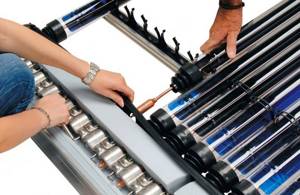
In order for the collector to work efficiently, it is necessary to correctly assemble and install the structure
Important! The efficient operation of the heating collector depends on the tightness of all connections.
Upon completion of installation, the system is tested. It is filled through a pipe at the bottom of the collector, which will eliminate the possibility of air locks. The coolant enters the storage tank until the optimal level is reached, which is regulated using a float valve. The heated liquid will rise in the front chamber and enter the heating system. Natural circulation occurs until the temperature of the fluid entering the radiator and that leaving the manifold are equalized.
When arranging a hydraulic system, it is necessary to install shut-off valves that prevent the reverse circulation of the coolant into the storage tank from the manifold. This phenomenon occurs when the ambient temperature decreases, which is typical for the evening or night time.
Equipment of systems working with solar collectors with automation
The specific operation of solar installations and constantly changing initial data (season, weather conditions, etc.) do not ensure stability of parameters (temperature, coolant flow, etc.), which requires the inclusion of control systems in the installation diagram.
Electronic devices such as a controller, based on an analysis of the temperature in certain places of the installation circuit, give commands to open/close valves, turn on/off pumping units to select the optimal movement of the coolant along the circuit. So, for example, if the temperature of the water in the coolant storage tank exceeds, the controller will stop its movement along the circuit, stopping heat loss that could be discharged into the environment through the collector.
Domestic manufacturers of solar collectors for home
A popular manufacturer of solar collectors is the New Pole company, which offers a wide range of models at affordable prices. A special place is occupied by flat devices made of aluminum. The coolant circulates through copper tubes equipped with double insulation protection, which ensures efficient operation of the system at low temperatures.

The domestic company Novy Polyus offers a wide range of collectors
Home heating equipment can be purchased complete with a storage tank, temperature controller and circulation pump. The average price of a solar collector will be 20-22 thousand rubles.
Another successful manufacturer of solar-to-thermal energy converters is the AltEnergia company, which produces flat-plate and vacuum collectors. The first version of the products can be supplied together with a boiler with a volume of 200-500 liters, which operates on the principle of indirect heating. Vacuum collectors are equipped with storage tanks of 100-1000 liters and circulation pumps.
Important! Products from AltEnergia are certified in Germany.
A flat device will cost about 13 thousand rubles. The price of a vacuum solar collector will be 35-50 thousand rubles.
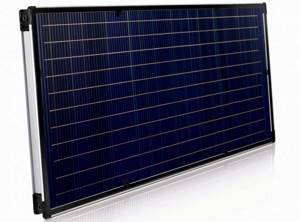
A flat solar collector from AltEnergia will cost about 13 thousand rubles
The domestic manufacturer ANDI Group specializes in the manufacture of vacuum-type manifolds. The main feature of the product is their ability to adapt to difficult weather conditions. Collectors are capable of converting energy even on cloudy days. Each bulb has a three-layer coating, which ensures maximum absorption of solar radiation. You can buy a solar collector for an average of 25-35 thousand rubles.
The NPO Mashinostroyenia company produces a range of solar collectors that are distinguished by their simple modification, functionality and affordable cost. The latest technologies are used in the manufacture of products. A distinctive feature of the collectors is the presence of a multilayer absorber, which is applied to the absorber using magnetic sputtering. This layer promotes maximum capture and retention of solar energy, resulting in device efficiency of 85-90%. You can buy a solar system for 15-20 thousand rubles.
Flat appliances
Their design is simpler than that of vacuum devices, and at the same time they are less efficient. The water is heated as it circulates through tubes attached to a thermally conductive substrate of copper or aluminum sheet called an absorber.
The substrate is thermally insulated from below, and from above it is protected by a transparent material that allows radiation to pass through - polycarbonate or tempered glass with a slight addition of metal.
The most effective device is a flat device with copper tubes that are soldered to a molded copper substrate. A manifold equipped with tubes made from cross-linked polyethylene absorbs less heat because they have lower thermal conductivity.
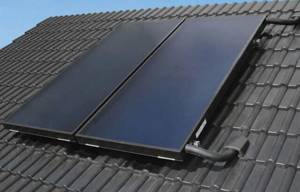
Flat devices have the following characteristics:
- Their working environment heats up to a maximum of 200 - 210 degrees.
- Solar energy absorption is up to 70%.
- Minimal reduction in heating efficiency in winter at the solar collector in snowy weather. The transparent sheet, which serves as protection for the substrate with the tubes, heats up during operation, as a result of which the snow cover quickly melts.
- Heat loss occurs. They arise as a result of contact of air heated in the device with the protective glass, but they do not exceed 30%. As the temperature outside decreases, the heat loss from the device begins to increase. It stops functioning at -20 °C and below.
- High windage. This property can become an obstacle to installing a flat-plate collector in regions where strong winds blow in winter.
- They are installed at an angle to the horizon so that the location provides them with maximum illumination throughout the day.



